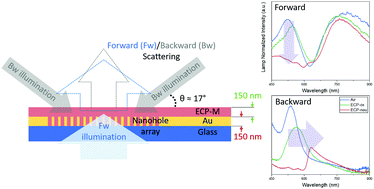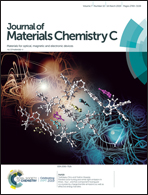Heterogeneous forward and backward scattering modulation by polymer-infused plasmonic nanohole arrays†
Abstract
The transmission and forward scattering of plasmonic nanohole arrays (NHAs) are widely examined in pursuit of non-fading plasmonic color filters for advanced displays and sensors. It is generally assumed that the reflection scattering is complementary to the corresponding transmission scattering and follows the same trend upon modulation of the dielectric environment. However, under oblique illumination, we observed peculiar and drastically different forward and backward scattering behavior of polymer-infused NHAs when a surrounding electrochromic polymer matrix was subjected to electrical potential, thereby changing the permittivity of the environment. Forward scattering at normal incidence angle of the NHAs is dominated by the extinction of the polymer coating, showing absorption-controlled attenuation behavior. In contrast, the concurrently monitored backward scattering at a highly oblique angle showed significant red-shifting in addition to attenuation. Our simulations suggest that the high incidence angle illumination in the backward scattering setup excites polarization dependent complex plasmon resonances that are highly sensitive to the modulation of the refractive index of the surrounding media. Such drastically different behavior of forward and backward scattering opens up possibilities for exploration of NHAs as prospective tunable reflection filters and colorimetric electrochemical sensors.



 Please wait while we load your content...
Please wait while we load your content...
